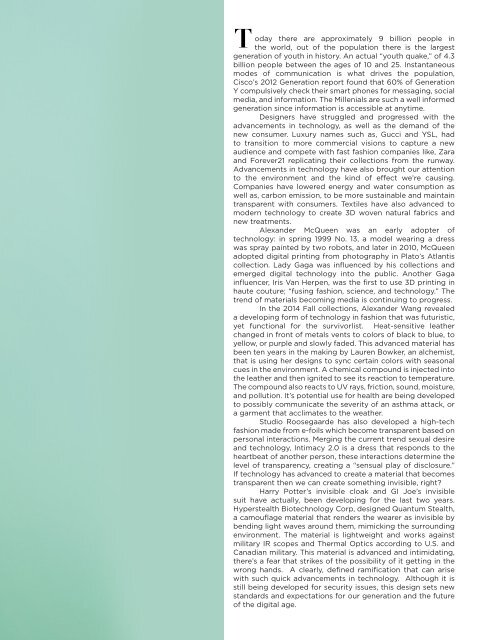FLAUNT - The Generation Issue
FLAUNT is the American fashion, culture magazine. The featured FLAUNT issue, themed as "The Generation Issue", narrates the idiosyncrasies of our current Y Generation from the digital age to our cultural icons. Compassing how we are being consumed by technology and regressing from it. This publication was created as a collaborative project for a Current Trends and Forecasting class at the Savannah College of Art and Design. It is a reproduction of our own FLAUNT magazine and is not an official FLAUNT publication.
FLAUNT is the American fashion, culture magazine.
The featured FLAUNT issue, themed as "The Generation Issue", narrates the idiosyncrasies of our current Y Generation from the digital age to our cultural icons. Compassing how we are being consumed by technology and regressing from it.
This publication was created as a collaborative project for a Current Trends and Forecasting class at the Savannah College of Art and Design. It is a reproduction of our own FLAUNT magazine and is not an official FLAUNT publication.
You also want an ePaper? Increase the reach of your titles
YUMPU automatically turns print PDFs into web optimized ePapers that Google loves.
T<br />
oday there are approximately 9 billion people in<br />
the world, out of the population there is the largest<br />
generation of youth in history. An actual “youth quake,” of 4.3<br />
billion people between the ages of 10 and 25. Instantaneous<br />
modes of communication is what drives the population,<br />
Cisco’s 2012 <strong>Generation</strong> report found that 60% of <strong>Generation</strong><br />
Y compulsively check their smart phones for messaging, social<br />
media, and information. <strong>The</strong> Millenials are such a well informed<br />
generation since information is accessible at anytime.<br />
Designers have struggled and progressed with the<br />
advancements in technology, as well as the demand of the<br />
new consumer. Luxury names such as, Gucci and YSL, had<br />
to transition to more commercial visions to capture a new<br />
audience and compete with fast fashion companies like, Zara<br />
and Forever21 replicating their collections from the runway.<br />
Advancements in technology have also brought our attention<br />
to the environment and the kind of effect we’re causing.<br />
Companies have lowered energy and water consumption as<br />
well as, carbon emission, to be more sustainable and maintain<br />
transparent with consumers. Textiles have also advanced to<br />
modern technology to create 3D woven natural fabrics and<br />
new treatments.<br />
Alexander McQueen was an early adopter of<br />
technology: in spring 1999 No. 13, a model wearing a dress<br />
was spray painted by two robots, and later in 2010, McQueen<br />
adopted digital printing from photography in Plato’s Atlantis<br />
collection. Lady Gaga was influenced by his collections and<br />
emerged digital technology into the public. Another Gaga<br />
influencer, Iris Van Herpen, was the first to use 3D printing in<br />
haute couture; “fusing fashion, science, and technology.” <strong>The</strong><br />
trend of materials becoming media is continuing to progress.<br />
In the 2014 Fall collections, Alexander Wang revealed<br />
a developing form of technology in fashion that was futuristic,<br />
yet functional for the survivorlist. Heat-sensitive leather<br />
changed in front of metals vents to colors of black to blue, to<br />
yellow, or purple and slowly faded. This advanced material has<br />
been ten years in the making by Lauren Bowker, an alchemist,<br />
that is using her designs to sync certain colors with seasonal<br />
cues in the environment. A chemical compound is injected into<br />
the leather and then ignited to see its reaction to temperature.<br />
<strong>The</strong> compound also reacts to UV rays, friction, sound, moisture,<br />
and pollution. It’s potential use for health are being developed<br />
to possibly communicate the severity of an asthma attack, or<br />
a garment that acclimates to the weather.<br />
Studio Roosegaarde has also developed a high-tech<br />
fashion made from e-foils which become transparent based on<br />
personal interactions. Merging the current trend sexual desire<br />
and technology, Intimacy 2.0 is a dress that responds to the<br />
heartbeat of another person, these interactions determine the<br />
level of transparency, creating a “sensual play of disclosure.”<br />
If technology has advanced to create a material that becomes<br />
transparent then we can create something invisible, right?<br />
Harry Potter’s invisible cloak and GI Joe’s invisible<br />
suit have actually, been developing for the last two years.<br />
Hyperstealth Biotechnology Corp, designed Quantum Stealth,<br />
a camouflage material that renders the wearer as invisible by<br />
bending light waves around them, mimicking the surrounding<br />
environment. <strong>The</strong> material is lightweight and works against<br />
military IR scopes and <strong>The</strong>rmal Optics according to U.S. and<br />
Canadian military. This material is advanced and intimidating,<br />
there’s a fear that strikes of the possibility of it getting in the<br />
wrong hands. A clearly, defined ramification that can arise<br />
with such quick advancements in technology. Although it is<br />
still being developed for security issues, this design sets new<br />
standards and expectations for our generation and the future<br />
of the digital age.


